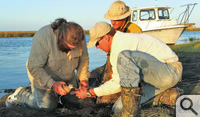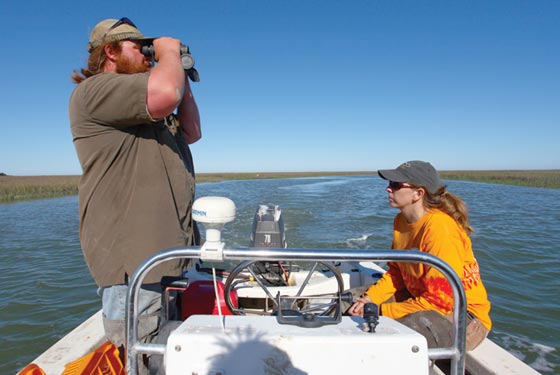Never trust a whimbrel
Shifty, stilt-legged shorebirds continue to surprise even seasoned scientists
Whimbrels routinely fly from the bottom of the world to the top. Somewhere along the line, they've developed a knack for doing the unexpected.
Scientists thought they had a pretty good handle on these wading birds and their hemispheric migrations. For starters, it is well known that whimbrels winter in southern climes, preferring coastal areas down both sides of South America, where it’s summer during our winter. In spring (our northern hemisphere spring, that is), they fly northward, seeking marshy, crab-rich areas such as Virginia’s Eastern Shore. They only stay a while among the creeks and marshes, resting and feeding for the last stage of their spring migration, when they take off for one of their breeding grounds in the far north.
A whimbrel might very well winter in Patagonia and, that same year, lay eggs within sight of the Arctic Ocean. Bryan Watts, director of the Center for Conservation Biology, explains that scientists had understood that there are two populations of the birds. The western whimbrels related to the Pacific Ocean and used breeding grounds near the Alaska-Canada border. Watts and his colleagues have been studying the eastern population, which nest in Ontario and Manitoba along the western side of Hudson Bay and James Bay.
But then two years ago, scientists at the Center for Conservation Biology began to realize that once a whimbrel takes off, only the bird knows the flight plan.
In 2008, a female whimbrel named Winnie made national news when she set a distance record for whimbrels in a 146-hour, 3,200-mile flight from the Eastern Shore to breeding grounds in the Mackenzie River basin near the Alaska-Canada border. At an average speed of 22 miles per hour, Winnie’s apparently nonstop flight overturned conventional scientific thinking about whimbrels, their habits and their migration patterns.
This year, a rambling, 5,600-mile odyssey by a bird named Hope continues the rewriting of the natural history of Numenius phaeopus. Hope surprised scientists by visiting both of the well-known northern whimbrel breeding grounds—and apparently not breeding. Watts said part of the explanation for Hope’s behavior lies in the late arrival of the arctic summer in the James Bay region.
Late arctic summer
 “They’ve had an incredibly late summer,” Watts said. “They’ve had a lot of snow cover and ice up to the north. It looks like a lot of these birds have gotten up there and then probably not been able to breed. The breeding season is so short that if the thaw-out is late, then they’re just not going to breed for the year.”
“They’ve had an incredibly late summer,” Watts said. “They’ve had a lot of snow cover and ice up to the north. It looks like a lot of these birds have gotten up there and then probably not been able to breed. The breeding season is so short that if the thaw-out is late, then they’re just not going to breed for the year.”
Researchers from the Center for Conservation Biology, a joint program of William & Mary and Virginia Commonwealth University, have been working with staff from The Nature Conservancy to track the movements of Winnie, Hope and other whimbrels by satellite. For the past two years, the scientists have been trapping these curved-billed wading birds at their migratory staging areas on the Eastern Shore. The birds are released unharmed, but wearing a tiny state-of-the-art satellite-tracking device that lets researchers follow the bird’s northward migration.
“This year we put out five solar powered transmitter units. These are the same units we used last year on two birds,” explained Libby Mojica, a research biologist at the center. “This year, we decided to increase the number of birds. We’re doing five in the spring and then we’ll be putting out an additional four in the fall.”
‘A completely ridiculous verb’
Scientists have been identifying birds for decades by trapping them, then putting identification-bearing bands on their legs. The verb describing the process, of course, is banding. The more high-tech version of banding, involving the attachment of satellite transmitters, has become known as “transmittering.”
“‘Transmittered’ sounds like a completely ridiculous verb,” Mojica admits, “but I have seen it many times.”
Mojica said the five transmittered whimbrels were released between May 18 and 22. Whimbrels use the Eastern Shore as a refueling point on their way north from the birds’ summer grounds that extend down both coasts of South America. They feed on the crabs abundant in the creeks and inlets of the Delmarva Peninsula, storing up energy to continue north to one of the two breeding grounds used by the species.
In the tradition of Winnie, the 2009 crop of transmittered whimbrels were given names. Mojica said all the names related to Eastern Shore landmarks near where they were trapped. Boxer for example, was named for Box Tree Creek, while Fowler’s name came from Fowling Point. Hope’s name came from Hope Creek.
Watts explained that Hope and other birds staging on the Eastern Shore were assumed to be part of the eastern population, whimbrels thought to remain separate from westerners.
Boxer flies north, then south
Some of the birds followed the expected migration scenario, confirming more than one aspect of scientific theory. Boxer, for instance, flew up to the James Bay breeding grounds, just like a good eastern whimbrel should. Then, an apparent victim of the late summer, Boxer blew off breeding and flew back down to the Eastern Shore, right to Box Tree Creek where he had been trapped in May.
“This is something we’ve been interested in. We’ve thought that these birds are really spatially structured; they go to specific sites. So Boxer is using the same staging area for the fall that he used in the spring,” Watts said. “It’s pretty wild to have that bird staging on that same little creek in the spring and again in the fall.
Last year, Winnie, expected to take the straight shot to James Bay like other eastern whimbrels, flew to Alaska instead. “Nobody expected that,” Mojica said. “Some shorebird biologists were questioning whether Winnie was just a fluke.”
The odyssey of Hope
This spring, Hope did not exactly follow Winnie’s wingbeats. Instead, she took a rather roundabout journey to James Bay, going through Pennsylvania and New York, even veering off northeast before heading for the mouth of James Bay. As expected, she spent several days in and around the whimbrel’s eastern breeding grounds. Then Hope tossed the script and took off for the western breeding grounds.
“That’s totally new information to us,” Watts said. “The eastern and western population of whimbrels were thought to be distinct and not overlapping. Then last year we had Winnie, who was clearly staging here with the eastern population, then went west. But Hope actually went up to the eastern breeding grounds—and then went over to the western area. Completely unexpected.”
Watts and his colleagues had a couple of clues that the western and eastern populations may not be completely separated. For one thing, he said, there is a marked dimorphism in size, with the western population running quite a bit larger than the easterners. In 2008, Winnie was the largest whimbrel ever captured on the Delmarva Peninsula. Hope was even larger than Winnie.
East, west—no difference?
Watts said it’s tempting to consider that the two breeding areas might be interchangeable, “but the morphology doesn’t support that. The western birds are significantly larger in body size than the eastern ones. That doesn’t argue for there being complete mixing between the two.”
Watts offered a couple possible scenarios for Hope’s behavior. One is that Hope is a westerner that for some reason staged at the eastern grounds on the Delmarva Peninsula. The second is that she is an eastern bird who found her proper breeding grounds inhospitable, likely because of the late spring, and set off for the western grounds.
“The former is more likely, because it would seem odd that the eastern population would know where the western population is breeding,” Watts said. “But it’s hard to say.”
 It’s a dangerous life
It’s a dangerous life
The satellite tracking project has confirmed one aspect of the whimbrel’s life: It’s a perilous one. This year’s breeding season was a wash for Boxer and Hope—and probably the entire eastern whimbrel population. After her record-setting migration flight of last year, Winnie got into trouble. She weathered several storms on her way south, finally dropping out of sight on the edge of Lake Superior. Watts figured that Winnie was worn out after fighting the storms and got stuck in an area with plenty of water, but no crabs to eat.
Hope hangs in there, so far
In August, Hope made landfall on St. Croix, in the U.S. Virgin Islands. She was not only tracked there by satellite, but a birder actually spotted Hope foraging for crabs.
Hope made landfall on St. Croix on the evening of Aug. 14 after completing an extraordinary 100-hour, 3,500-mile flight out over the open ocean. She left South Hampton Island in upper Hudson Bay on Aug. 10.
Watts said that he expected hope to stage in the Virgin Islands for two to three weeks before heading down to South America to winter.
But, once again, a whimbrel won’t be outguessed. As of mid-October, the satellite tracking device showed Hope still in the Virgin Islands. 
















